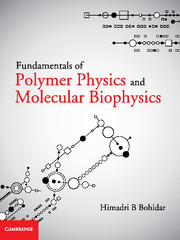Book contents
- Frontmatter
- Contents
- List of Figures
- List of Tables
- Preface
- 1 Essential Thermodynamic and Statistical Concepts
- 2 Polymer Structure and Nomenclature
- 3 Polymer Solutions
- 4 Phase Stability and Phase Transitions
- 5 Static Properties of Single Chains
- 6 Diffusion
- 7 Viscosity of Polymer Solutions
- 8 Sedimentation
- 9 Concentration Regimes and Scaling
- 10 Internal Dynamics
- 11 Dynamics in Polymer Gels
- 12 Molecular Biophysics
- 13 Structure of Biopolymers
- 14 Physics of Proteins
- 15 Physics of Nucleic Acids
- 16 Special Topics
- Index
- References
8 - Sedimentation
Published online by Cambridge University Press: 05 August 2014
- Frontmatter
- Contents
- List of Figures
- List of Tables
- Preface
- 1 Essential Thermodynamic and Statistical Concepts
- 2 Polymer Structure and Nomenclature
- 3 Polymer Solutions
- 4 Phase Stability and Phase Transitions
- 5 Static Properties of Single Chains
- 6 Diffusion
- 7 Viscosity of Polymer Solutions
- 8 Sedimentation
- 9 Concentration Regimes and Scaling
- 10 Internal Dynamics
- 11 Dynamics in Polymer Gels
- 12 Molecular Biophysics
- 13 Structure of Biopolymers
- 14 Physics of Proteins
- 15 Physics of Nucleic Acids
- 16 Special Topics
- Index
- References
Summary
Settling down of heterogeneous suspensions over a period of time is a common phenomenon in everyday life. Such processes are very slow and completely governed by the uniform gravitational field of the earth. The importance of sedimentation as an analytic method to examine differential molecular weight of particles dispersed in a solvent medium was realized by Mason and Weaver (1924). The method was further developed into a novel branch of molecular transport theory by Svedberg (Svedberg and Pederson 1940). Determination of the molecular weight of synthetic polymers, proteins, nucleic acids and polysaccharides is of prime importance to both physical and organic chemists. Sedimentation methods have enjoyed remarkable popularity in analytic chemistry as reliable and robust tools. It must be realized that similar to molecular diffusion, sedimentation is a purely transport process. In fact, diffusion and sedimentation are competing processes in any given polymer–solvent system. Further any treatment of molecular transport in the dispersion medium, the flow equations are constituted following irreversible thermodynamic concepts. Thus, sedimentation equilibrium behaviour of polymer molecules in a solvent is significantly dependent on conformation, concentration, molecular weight and molecular charge density of the polymer. This makes the data interpretation of sedimentation experiments tedious. At the same time, one of the compelling reasons why the experiments to determine the molecular weight of proteins have been successful is because, for relatively homogeneous globular protein dispersions, the thermodynamic non-ideal terms are negligible and experimental data analysis is not cumbersome. In this chapter, some basic and essential features of sedimentation equilibrium will be discussed.
Information
- Type
- Chapter
- Information
- Fundamentals of Polymer Physics and Molecular Biophysics , pp. 138 - 149Publisher: Cambridge University PressPrint publication year: 2015
